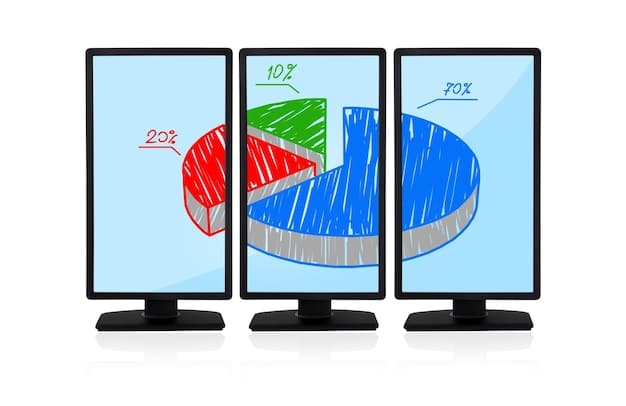Decoding US Trade Regulations: 2025 Compliance Guide for Businesses

Decoding the New US Trade Regulations involves understanding complex legal frameworks and adapting business practices to comply with updated mandates effective in 2025, ensuring smooth international trade operations and avoiding penalties.
Navigating the intricate landscape of United States trade regulations can be daunting, especially with continuous updates and amendments. This guide, decoding the new US trade regulations: A step-by-step guide to compliance for businesses in 2025, aims to provide clarity and actionable steps to ensure your business remains compliant and competitive in the global market.
Understanding the Evolving US Trade Landscape
The United States trade landscape is constantly evolving due to geopolitical shifts, technological advancements, and policy changes. Businesses engaged in international trade need to stay informed about these developments to avoid potential disruptions and capitalize on new opportunities. Staying ahead means more than just knowing the rules; it’s about understanding the reasons behind them and anticipating future trends.
Key Factors Influencing Trade Regulations
Several key factors drive changes in US trade regulations. These include international trade agreements, national security concerns, and domestic economic policies. Monitoring these factors can provide insights into upcoming regulatory changes.
- Trade Agreements: Agreements like the USMCA and potential new deals with other nations significantly impact trade rules.
- National Security: Regulations may tighten or loosen based on perceived threats and strategic priorities.
- Economic Policies: Changes in tariffs, quotas, or export controls can reflect broader economic strategies.
Adapting to these changes requires a proactive approach. Businesses need to invest in resources that provide real-time updates and expert analysis of the trade environment. This can include subscribing to industry publications, attending trade conferences, and partnering with trade consultants.

Step 1: Assessing Your Current Compliance Status
Before implementing any new strategies, it’s crucial to evaluate your current compliance status. This involves reviewing your existing trade practices, identifying potential gaps, and understanding the specific regulations that apply to your products or services. A thorough assessment will lay the groundwork for a robust compliance plan.
Conducting a Trade Compliance Audit
A trade compliance audit is a comprehensive review of your trade-related activities. This audit should cover import/export documentation, classification of goods, valuation methods, and adherence to export control regulations. Regular audits help identify areas of non-compliance and ensure that corrective actions are taken promptly.
The audit should also assess your internal controls and procedures. Are your employees adequately trained on trade compliance matters? Do you have systems in place to monitor and track your trade activities? Addressing these questions will help strengthen your compliance framework.
Businesses should also consider using technology to streamline the audit process. Trade compliance software can automate data collection, identify discrepancies, and generate reports, making the audit more efficient and accurate.
Step 2: Understanding New Regulations Effective in 2025
Staying informed about the specific changes to US trade regulations that will come into effect in 2025 is paramount. These may include revisions to tariff classifications, new export control measures, or updates to free trade agreements. Understanding these changes will allow you to proactively adjust your strategies and avoid compliance issues.
Key Regulatory Updates for 2025
Several areas of trade regulation are likely to see significant changes in 2025. These include updates to the Harmonized Tariff Schedule (HTS), new sanctions and export control laws, and modifications to customs enforcement procedures.
- Harmonized Tariff Schedule (HTS): Changes to product classifications can impact tariff rates and import duties.
- Export Controls: New restrictions may be placed on the export of certain technologies or goods to specific countries.
- Customs Enforcement: Increased scrutiny and stricter penalties for non-compliance can affect import and export processes.
To stay ahead of these changes, businesses should closely monitor regulatory updates from agencies such as the US Customs and Border Protection (CBP), the Bureau of Industry and Security (BIS), and the Office of Foreign Assets Control (OFAC). These agencies provide valuable information and guidance on compliance matters.
Step 3: Implementing a Comprehensive Compliance Program
A comprehensive compliance program is essential for ensuring that your business adheres to all relevant trade regulations. This program should include policies, procedures, training, and monitoring mechanisms to prevent and detect violations. A well-designed program will not only minimize risk but also enhance your business’s reputation and competitiveness.
Essential Components of a Compliance Program
A robust compliance program should include several key components. These include a written compliance policy, regular training for employees, due diligence procedures for suppliers and customers, and internal monitoring and auditing mechanisms.
The written compliance policy should outline your company’s commitment to complying with all applicable trade laws and regulations. It should clearly define roles and responsibilities, establish reporting procedures, and provide guidance on ethical decision-making.

Step 4: Leveraging Technology for Compliance
In today’s digital age, technology plays a crucial role in simplifying and automating trade compliance processes. Trade compliance software can help you manage complex regulations, track shipments, screen parties, and generate reports. By leveraging technology, you can improve efficiency, reduce errors, and enhance your overall compliance efforts.
Benefits of Trade Compliance Software
Trade compliance software offers numerous benefits. It can automate tasks such as tariff classification, export screening, and import documentation. It can also provide real-time updates on regulatory changes and facilitate communication with customs authorities.
- Automation: Automates repetitive tasks, freeing up resources for more strategic activities.
- Accuracy: Reduces the risk of human error in data entry and analysis.
- Visibility: Provides real-time visibility into your trade operations, allowing you to identify and address potential issues quickly.
When selecting trade compliance software, consider factors such as the size and complexity of your business, the specific regulations you need to comply with, and your budget. Look for software that offers scalability, flexibility, and integration with your existing systems.
Step 5: Continuous Monitoring and Improvement
Trade compliance is not a one-time effort but an ongoing process. Regularly monitor your trade activities, stay informed about regulatory changes, and continuously improve your compliance program. This will help you maintain compliance, mitigate risks, and adapt to evolving business conditions.
Strategies for Continuous Improvement
To ensure continuous improvement, implement strategies such as regular compliance audits, employee feedback mechanisms, and performance metrics. Use the results of audits and feedback to identify areas for improvement and implement corrective actions.
Regularly review and update your compliance policies and procedures to reflect changes in regulations or business practices. Conduct periodic training sessions to keep employees informed about their responsibilities and the latest compliance requirements.
Step 6: Staying Informed About Future Trends
The future of trade regulation is likely to be shaped by emerging technologies, geopolitical shifts, and evolving economic priorities. Staying informed about these trends will enable you to anticipate future regulatory changes and prepare for them proactively. Keeping your business ahead requires continuous learning and adaptation.
Anticipating Future Regulatory Changes
Several trends are likely to influence US trade regulations in the coming years. These include the increasing use of artificial intelligence in customs enforcement, the growing focus on supply chain security, and the potential for new trade agreements with emerging markets.
- AI in Customs: Increased use of AI for risk assessment and fraud detection
- Supply Chain Security: Closer scrutiny of supply chains to prevent illicit trade and ensure product safety.
- Emerging Markets: Potential for new trade deals with countries in Asia, Africa, and Latin America.
By staying informed about these trends, businesses can anticipate future regulatory changes and prepare for them proactively. This will not only minimize compliance risks but also create opportunities for growth and innovation.
| Key Point | Brief Description |
|---|---|
| 📊 Compliance Assessment | Evaluate current trade practices to identify gaps. |
| 📝 Regulatory Updates | Stay informed about HTS, export control, etc. |
| ✅ Compliance Program | Implement policies, training, and monitoring. |
| 🤖 Tech Integration | Use software for automation and accuracy. |
Frequently Asked Questions (FAQ)
▼
Businesses should focus on tariff classifications, export controls, sanctions compliance, and customs documentation. Staying current with changes to these areas is critical for avoiding penalties and ensuring smooth trade operations.
▼
A business should conduct a trade compliance audit at least annually. More frequent audits may be necessary if the business operates in a high-risk industry or has experienced compliance issues in the past.
▼
Technology can automate many aspects of trade compliance, such as tariff classification, export screening, and import documentation. It can also provide real-time updates on regulatory changes and facilitate communication with customs authorities.
▼
Non-compliance can result in penalties, fines, seizure of goods, and even criminal charges. It can also damage a business’s reputation and lead to loss of customers and suppliers. Compliance is essential for long-term success.
▼
Businesses can stay updated by monitoring regulatory updates from agencies like CBP, BIS, and OFAC; subscribing to industry publications; attending trade conferences; and partnering with trade consultants. Continuous learning is key.
Conclusion
In conclusion, navigating the evolving US trade regulations requires a proactive, informed, and comprehensive approach. By assessing your compliance status, understanding new regulations, implementing a robust compliance program, leveraging technology, and staying informed about future trends, your business can ensure it is well-prepared for the changes coming in 2025 and beyond.





